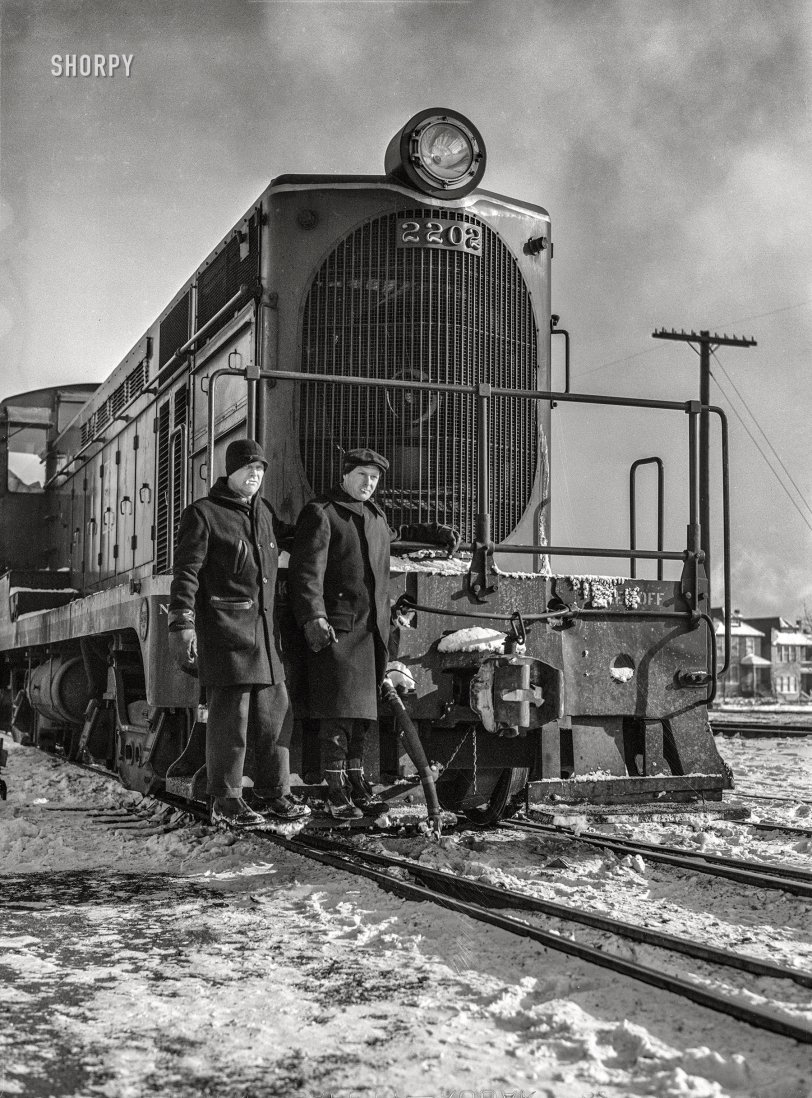


Framed or unframed, desk size to sofa size, printed by us in Arizona and Alabama since 2007. Explore now.
Shorpy is funded by you. Patreon contributors get an ad-free experience.
Learn more.

- Complicated then, forgotten now
- Bryan-Stevenson
- Skinny is as skinny does
- How do you rest in peace
- Riding the footboards
- Alas, hidden from view
- Baldwin Diesels
- Exclusive pump
- Bananas, Oysters and Smokey Joe
- Details, Details
- What's that building to the left of the tower?
- Coal Barges
- Bromo-Seltzer
- Inner harbor
- The Basin
- What a headache!
- Giant stepladder?
- Yeah, it was cold
- Love those coats
- Link & Pin Days Remnant
- Baldwin 62303
- Baldwin VO-1000
- Cold
- No expense spared
- Tough Guys
- What's your hurry, where's your hat?
- Sheriff's Signature
- Relocated in the Eighties
- Lost in Toyland
- And without gloves
Print Emporium
Switchcraft: 1943

March 1943. "Chicago, Illinois. Switchmen riding one of the Atchison, Topeka and Santa Fe diesel switch engines." Photo by Jack Delano for the Office of War Information. View full size.
Riding the footboards
Once a very common practice, it was obviously quite dangerous - one slip when riding on a moving locomotive would put you directly under the wheels, which as you can imagine led to a horrific result. The practice was eventually outlawed in the 1970s and all footboards on existing locomotives removed by around 1980.
Baldwin Diesels
Baldwin was a large successful manufacturer of steam locomotives that struggled to make the transition to diesel power and eventually exited the market in the mid 1950's.
This early offering illustrates some of Baldwin's thinking including an indestructible cast steel frame, the cast numerals for the locomotive number, and the electrical receptacles on the top corner of the front hood that could be used to plug in marker lights attached to the side brackets. Baldwin would soon economize this design with a flat grille for the radiators and a painted road number. Here is sister 2252 near the end of her career in 1966 with different trucks and a rakish multi-stack exhaust. https://www.railpictures.net/photo/392182/
Yeah, it was cold
There's no fashion involved for those two - March of '43 started out colder than normal and those two knew how to keep warm. I bet they had some good wool underneath as well.
Love those coats
... and if you've never experienced the warmth of winter weight wool pants on a cold Northern day, you're missing out. Our ancestors knew how to handle the weather in a way we too often do not.
Link & Pin Days Remnant
It's surprising to see that the knuckle of the coupler has the slot across its face that would have allowed it to couple with the link & pin coupler system outlawed around 1900. The early Janey couplers came with the slot for the transition period between the systems. That slot weakened the knuckle and they failed to the point that some suggested a return to the link & pin. Fortunately, the railroads were making more money hauling longer trains with the new coupler and the number of brakemen losing fingers and hands started to recede from the tens per day that had been the norm.
Baldwin 62303
The build plate is next to Lefty's right glove. No. 62303 was Baldwin's third VO-1000 diesel, completed 12/12/1939
Baldwin VO-1000
According to my ATSF all-time diesel guide, #2202 was a Baldwin VO-1000 delivered in 1939. Prior to seeing this photo, I didn't know that the Santa Fe received VO-1000 locos that had an oval radiator grille instead of the later rectangular one.
Cold
Wool pants and coats, heavy mitts, hats over the ears – it’s definitely cold here. Plus I like the twin ciggies.
No expense spared
Note that the AT&SF went with fancy raised metal numbers on the engine's number plate when Baldwin built this engine for them in 1939. Simply painting the numbers would have been a lot cheaper.
Tough Guys
You do not want to be a hobo riding the rails and run into these two!

























On Shorpy:
Today’s Top 5